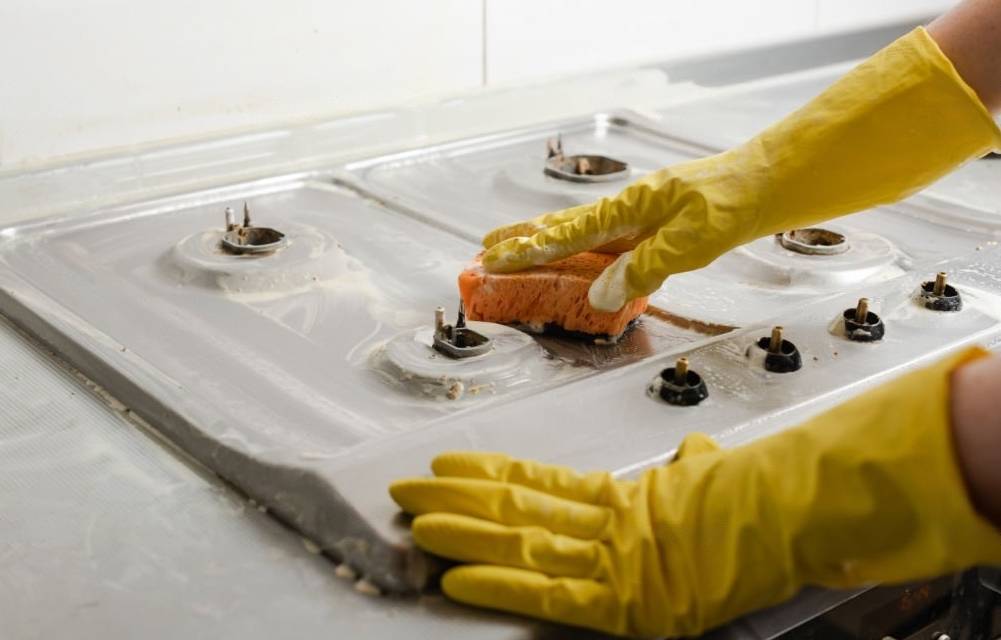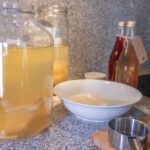Keeping your stove clean is not only important for keeping your home clean and healthy. Learning some stove cleaning hacks also helps your stove work better and last longer. A dirty stove doesn’t just look bad; it can also change the taste of your food and put you in danger. With a few easy-to-use cleaning hacks, you can easily get rid of tough spots, grease, and grime and have a stove that looks like new. In this piece, we’ll look at some clever ways to clean your stove that will save you time and make it look its best.
Why Cleaning a Stove is Important

Regularly cleaning your stove offers numerous benefits beyond just aesthetics. Let’s take a look at why it’s crucial to keep your stove clean:
- Improved Food Flavor: A clean stove makes sure there are no leftover food bits or residue that can change the taste and smell of your meals.
- Efficient Heating: A clean stove lets heat move around better, making sure that your food cooks properly and quickly.
- Enhanced Safety: Accumulated grease and grime on your stove can be a fire hazard. Regular cleaning reduces the risk of accidental fires and keeps your kitchen safe.
- Extended Lifespan: By keeping your stove clean, you can stop tough spots and harmful substances from building up, which will make it last longer.
Now that we understand the importance of stove cleaning, let’s delve into some practical stove cleaning hacks and tips to make the task easier.
See also: How to keep your bathroom clean everyday (Home remedies)
Basic Stove Cleaning Hacks & Tips
- Gather Supplies: Start by getting the cleaning tools you’ll need, like light dish soap, microfiber cloths, baking soda, vinegar, and a scrub brush.
- Remove Burner Grates and Drip Pans: Take the grates and drip pans off the burners and soak them in warm soapy water to make cleaning them easy.
- Wipe Down the Stove Surface: Use a damp cloth or sponge to wipe away loose debris and surface dirt.
- Degrease the Burner Grates: Make a mix with baking soda and water to clean dirty grates. Apply the paste to the grates, let it sit for 15 minutes, then scrub with a brush and rinse well.
- Clean Drip Pans: Soak the drip pans in a mixture of vinegar and baking soda to remove stubborn stains and grease. Scrub them gently and rinse well.
- Address Control Knobs and Buttons: Take off the knobs and use a wet cloth to clean them. Put a toothbrush in some warm water and gently scrub the knobs and buttons to get rid of dirt that won’t come off.
- Clean the Stovetop Surface: you can use a cleaner made for that material or a mixture of vinegar and water depending on what your stovetop is made of. Pay special attention to any spots or spills as you clean the surface.
- Dry and Reassemble: Make sure to dry all the components thoroughly after cleaning. Reassemble the burner grates and drip pans back onto the stove once it’s dry.
Must have tools for stove cleaning
Having the right tools and supplies can make it easier to clean your stove. Check out this list of things you must have:
| Cleaning Supplies | Description |
|---|---|
| Microfiber Cloth | Surface-cleaning wipes that are soft and work well |
| Soft Bristle Brush | It’s perfect for cleaning buttons and burners |
| Mild Cleaner | Material that can be used on your stove |
| Baking Soda | Natural scrubbing agent for tough spots |
| White Vinegar | Cleans and kills germs naturally |
If you have these important cleaning tools and supplies on hand, you will be ready to clean your stove.
Make sure to always clean your stove according to the rules and suggestions given by the maker. Check the user manual for any other cleaning tips.
Natural Cleaning Solutions
If you prefer to use natural and eco-friendly cleaning solutions, here are a few options:
- Vinegar and Water: Mix equal parts white vinegar and water in a spray bottle. Spray the solution on the stovetop surface and wipe it clean with a cloth. Vinegar helps cut through grease and disinfects the surface.
- Baking Soda Paste: Make a paste by mixing baking soda and water. Apply the paste to stains or tough grease spots, let it sit for a few minutes, and then scrub and rinse. Baking soda is a mild detergent that helps get rid of tough spots.
- Lemon Juice: Squeeze fresh lemon juice onto the stovetop surface and let it sit for a few minutes. The acidity of the lemon helps break down grease and leaves a fresh citrus scent.
See also: Top 3 Eco-Friendly Cleaning Hacks
Comparing Cleaning Solutions: Pros and Cons
When it comes to cleaning your stove, there are various cleaning solutions available. Let’s take a closer look at some popular options and compare their pros and cons:
| Cleaning Solution | Pros | Cons |
|---|---|---|
| Vinegar and Water | – Natural and non-toxic – Effective against grease – Disinfects surfaces | – Strong odor – May not remove tough stains |
| Baking Soda Paste | – Gentle abrasive for stain removal – Safe for most surfaces – Easily accessible | – Requires some scrubbing – Not suitable for all types of stains |
| Commercial Cleaners | – Specifically formulated for stove cleaning – Removes stubborn stains and grease – Convenient to use | – May contain harsh chemicals – Potential health hazards if not used properly |
| Lemon Juice | – Natural degreaser | – Not as powerful as other solutions – May not remove heavy grease |
Removing Stubborn Stains and Grease
For those challenging stains and grease spots that require extra attention, try these stove cleaning hacks:
- Use a Steam Cleaner: Steam cleaners are very good at getting rid of stubborn spots and grime. Use a steam cleaner made for cooking surfaces and follow the directions that come with it.
- Ammonia Solution: Mix one part ammonia with three parts water to make a solution if your stovetop is made of glass or ceramic. Apply the solution to the damaged areas and let it sit for a few minutes. Wipe it clean after applying.
- Commercial Degreasers: There are several commercial degreasers available that are specifically formulated for stove cleaning. Use the product exactly as directed to get the best results.
Remember to always test any cleaning solution on a small, inconspicuous area of your stove before applying it to the entire surface.
Deep Cleaning Techniques

Deep cleaning your stove on a periodic basis helps maintain its performance and appearance. Here are some techniques to achieve a thorough clean:
- Remove Burner Elements: If your stove has removable burner elements, take them out and soak them in warm soapy water. Scrub off any residue and dry them before reinserting.
- Clean Oven Interior: If your stove has a built-in oven, don’t forget to clean the interior as well. Refer to the manufacturer’s instructions for the appropriate cleaning method.
- Polish Stainless Steel Surfaces: For stainless steel stoves, use a stainless steel cleaner and a microfiber cloth to polish and restore the shine.
Cleaning Different Types of Stoves
Different types of stoves may require specific cleaning methods. Here are some tips for cleaning gas, electric, and induction stoves:
Gas Stoves
Remove burner grates, burner caps, and control knobs. Clean them using the methods mentioned earlier. Wipe the stovetop surface, including the burners, with a damp cloth or a suitable cleaner.
Electric Stoves
Allow the coils or electric elements to cool completely. Remove them and clean them separately. Wipe down the stovetop surface, control panel, and knobs using a damp cloth or a mild cleaner. Be cautious not to wet the electrical components.
Induction Stoves
As with electric stoves, allow the surface to cool before cleaning. Use a soft cloth or a cleaner specifically designed for induction stoves. Avoid scratching materials.
Maintenance and Preventive Measures
- Wipe Spills Immediately: Clean up any spills or splatters on the stovetop as soon as they happen so they don’t harden or leave stains.
- Use Stovetop Protectors: You could use stovetop shields or liners to catch spills and keep them from hitting the surface. These are easy to take off and clean.
- Regularly Clean Ventilation: Clean the stove’s ventilation system, which includes the range hood and fans, on a regular basis to keep grease from building up and to make sure air can flow well.
- Cover Pots and Pans: When cooking, cover your pots and pans to reduce splatters and keep the stovetop cleaner.
- Perform Regular Maintenance: Follow the manufacturer’s advice for cleaning and replacing filters and other normal care jobs to keep your stove in great shape.
Comparing Stovetop Materials: Cleaning Considerations
Stovetop materials differ in durability and cleaning. Let’s compare some prevalent stovetop materials and their respective maintenance requirements:
| Stovetop Material | Cleaning Considerations |
|---|---|
| Glass/Ceramic | – Avoid using abrasive cleansers – Employ soft, non-scratch cleaning instruments – Clean up accidents immediately – Do not drag cookware across the surface |
| Stainless Steel | – Use mild stainless steel cleaners – Wipe with the grain to prevent scratching – Avoid abrasive materials – Polish regularly to maintain shine |
| Cast Iron | – Season the surface to enhance its natural non-stick properties – Avoid using soap or harsh chemicals – Clean with hot water and gentle scrubbing – Dry thoroughly to prevent rusting |
Understanding the specific maintenance requirements of your cooktop material will allow you to preserve its appearance and extend its life.
Cleaning Frequency: Quick Reference Guide
It is essential to establish a cleansing routine for your burner. Use this fast guide to determine how often to sanitize your stove’s various components:
| Stove Component | Cleaning Frequency |
|---|---|
| Stovetop Surface | Once a week |
| Burner Grates | Once a month |
| Drip Pans | Once a month |
| Oven Interior | Every 3-6 months |
| Control Knobs | Once a month |
Safety Precautions
When you clean your stove, you should put safety first. Here are some things to keep in mind about safety:
- Turn Off the Stove: Make sure the stove is off and fully cool before you clean it to avoid burns or other mistakes.
- Wear Protective Gear: To protect your skin and eyes, think about putting on gloves and safety glasses when using cleaning products or getting rid of tough spots.
- Ventilate the Area: Open windows or use a ventilation fan to make sure there is enough movement while cleaning, especially if you are using strong cleaning products.
- Keep Children and Pets Away: Keep kids and pets away from the cleaning area and put cleaning supplies where they can’t get to them to avoid accidents.
- Read Product Labels: Always read and follow the instructions and warnings on cleaning product labels to use them safely and effectively.
Conclusion
A clean stove not only makes your kitchen look better, but it also makes cooking safer and more fun. By using these stove cleaning hacks, tips and tricks as part of your normal cleaning routine, you can easily keep your stove clean and running well. Make sure to choose cleaning methods and solutions that are right for the material of your stove, and always put safety first. With a little work and regularity, you can have a stove that is spotless and makes cooking fun.
Frequently Asked Questions (FAQs)
How often should I clean my stove?
Clean the stove weekly. A deeper cleaning should be done once a month or as needed.
Can I use abrasive cleaners on my stove?
Don’t use harsh cleaners on sensitive surfaces (eg: glass or ceramic stovetops) because they can scratch them. Instead, use soft cleaners or things that come from nature.
Is it safe to use vinegar on a stainless steel stove?
Yes, vinegar can be used safely on stainless steel. But you should always dilute it with water. Try it out on a small area first to make sure it doesn’t stain.
Can I clean the inside of my oven using the same methods?
The inside of your oven may require specific cleaning methods. Refer to your oven’s user manual for instructions on how to clean the interior effectively and safely.
How can I prevent scratches on a glass stovetop?
To prevent scratches, avoid dragging pots and pans across the surface. Use cookware with smooth bottoms and lift them instead of sliding. Clean with non-abrasive materials and avoid using heavy pressure.
What should I do if food has burned onto the stovetop surface?
Make a mix with baking soda and water to clean food that has been burned. Apply the paste to the affected area. Let it sit for a while and then use a soft cloth or sponge to gently scrub the area.
Can I use a razor blade to remove stubborn stains on my stovetop?
It is generally not recommended to use a razor blade on a stovetop surface as it may scratch or damage it. Instead, try using gentle scrubbing techniques or specialized cleaners.
How can I maintain the shine of my stainless steel stove?
Clean your stainless steel stove often with a soft cloth and a mild stainless steel cleaner to keep its shine. Don’t use things that are rough and could scratch the skin.
Can I use bleach to clean my stove?
It is not recommended to use bleach on a stove, as it may damage the surface and leave harmful residues. Stick to milder cleaning agents and natural solutions.
Is it necessary to clean under the stovetop surface?
It is important to periodically clean under the stovetop surface to prevent the accumulation of grease, debris, and potential fire hazards. Refer to your stove’s manual for instructions on how to safely access and clean the area.
Remember to always refer to your stove’s user manual for specific cleaning instructions and recommendations based on the model and type of stove you have.
Thank you for reading this comprehensive guide on stove cleaning hacks. With these tips and techniques, you can keep your stove in top condition, ensuring a clean and inviting kitchen environment. Enjoy cooking in a spotless and functional space!

As a dedicated mother and passionate software developer, she weaves her diverse experiences into captivating stories that inspire and engage readers. Emma's love for sustainable living and environmental consciousness permeates both her personal and professional life. When she's not immersed in the world of coding and software development, Emma can be found nurturing her family and tending to her thriving organic garden. Her commitment to sustainable practices extends to every aspect of her life, from repurposing household items to embracing eco-friendly technologies.










